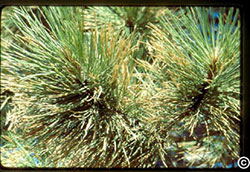What is winter browning of evergreens?
Brown evergreen needles, needle tips and branch tips are a common sight during the winter and early spring months in Colorado. These are all examples of winter injury usually caused by the drying winds, lack of snow cover, fluctuating temperatures, and low soil moisture that are typical of Colorado’s fall and winter seasons.
What causes winter browning?

Evergreen needles transpire or lose moisture during the winter months. To keep functioning well, the plant must replace lost moisture through its roots. But sometimes roots are unable to keep up with the moisture loss, especially in windy conditions when water rapidly evaporates from the needles. In some cases, there’s plenty of soil moisture, but plants are unable to absorb it, because the ground is frozen. In other cases, there isn’t enough soil moisture available to evergreens. As a result, the needle tissue dries out, turning brown or red.
How can I prevent winter browning of evergreens?
To reduce or prevent winter injury, water the root area of evergreens during dry fall and winter months. When snowmelt and rainfall are inadequate, apply water monthly during warm periods when the soil can absorb it. Apply mulch over the root zone to help conserve soil moisture and reduce loss from desiccation.
Can winter browning be reversed?
Although it’s unattractive, winter injury symptoms are eventually masked in the spring when new growth develops and old needles drop. Affected plant parts don’t usually need to be removed.
For “Fall & winter watering” refer to message number 1706.
For more information, see the following Colorado State University Extension fact sheet(s).



